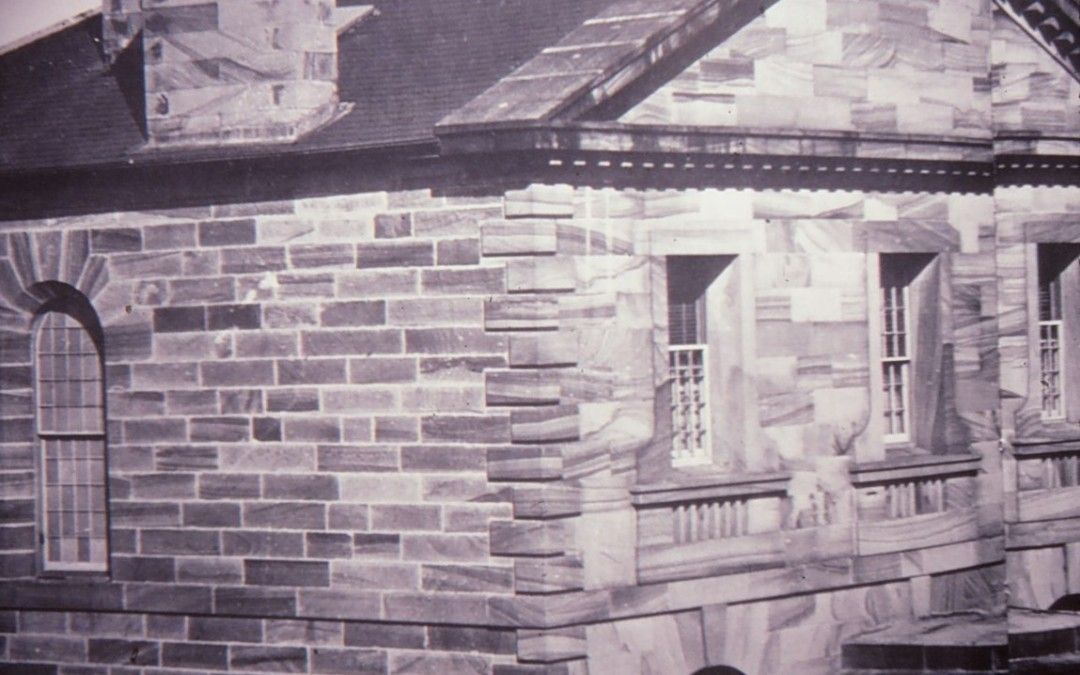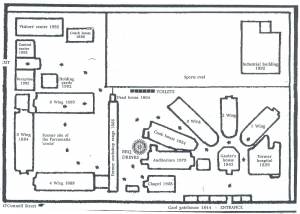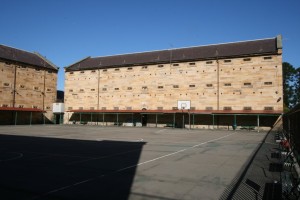
There were a number of sites owned by the Department of Corrective Services situated on over 10 hectares of land around the Parramatta Gaol. These included the Parramatta prison, the Parramatta linen service and the Merinda Periodic Centre.
Parramatta Correctional Centre. Source: James Semple Kerr, commissioned by NSW Public Works for the Department of Corrective Services, 1995.
Merinda Periodic Detention Centre – is a single story timber building used to house maximum of 19 female inmates from Friday to Sunday. During the week, it was a conference centre and overnight accomodation for staff.
Motor maintenance and stores complex – repair and maintenance was carried out here for all the vehicles associated with Parramatta Gaol and Parramatta Linen Service
PWD compound – consists of a group of nine galvanised iron sheds that were used to store lawn mowers and other garden tools used by the prisoners.
Area East of the Parramatta Gaol
Between the Dunlop St. and Barney St., there are two timber residences to accommodate officers. These residences were built in early 1900s. One of the residences on the southern side was used as officers mess hall, while the other one on the northern side was used as recreational hall. The northern residence was used as male detention centre to house 22 inmates on the weekends.
There are two single story cottages between the Barney St. and Board St. One of the cottages was occupied by ten parole officers, one welfare officer and administrative staff of the Parramatta Probation and Parole Service. The second cottage was used for administrative functions on 24 hours basis e.g. handling of emergency situations, movement of prisoners for Parramatta, Malwa, Silverwater, Norma Parker centre and Emu Plains Gaols.
Prisoners spending – According to Parramatta Gaol Study conducted by NSW Department of Public Works in 1980 – prisoners in Parramatta Gaol earned between $12 to $32 per week. Collectively all the prisoners were earning $500,000. Many prisoners were sending all their money at home where as $48,000 annually was spent on radios, record players, tapes, books and art craft material. According to 1974 prison census, 53.7% of Parramatta gaol inmates were aged between 26 and 34, with 32.4% under the age of 26.
The Gaol Complex
Parramatta Gaol complex cover is spread in approximately 4.4 hectares – from Dunlop St. in the south to the banks of the Darling Mills Creek in the north. The Gaol area is rectangular in shape (345m x 130m) and has three defining areas: the Gaol, Linen service, and the sports yard, which was surrounded by 6 meter high secure walls.
Linen Service– the Parramatta Linen Service had an industrial laundry, landscaped lawns, a gatehouse, and vehicle lock connecting the zone with the Gaol. Linen service used to provide laundry service to the range of state institutions and provide employment to the inmates.
Gaol and Sports Yard – The Gaol zone is divided by Bootshop building into two sectors – the northern and southern sectors.
Northern Sector:
Gatehouse – the purpose of this was control the access of prisoners, visitors, staff, and vehicle access to the gaol. Gatehouse was also the communication centre for calling prisoners to the visits. CCTV cameras were also controlled from the gatehouse.
Three radical accommodation wings
Wing 1 – approx 10.8m2 and accommodate 30 long term inmates
Wing 2 – app 9.3m2 and accommodate 30 cookhouse staff
Wing 3 – app 10.0m2 and accommodate 92 houses remand and reception inmates
Administration buildings
Bakehouse
Auditorium
Cookhouse – used to provide cooked food for Gaol inmates. Food was prepared in the cookhouse building and was taken to all the wings by trollies for distribution.
Chapel – this was used for services conducted by the Salvation Army and for band practice, meditation and prisoners weddings.
Bootshop – The bootmaker or Tinsmith building separate wings 1, 2 and 3 from wings 4, 5 and 6. The bootshop is been used for various things over the years. Tailor shop was at the first floor whereas ground floor was used for office, building maintenance workshop, prisoners canteen and television repair shop.
Southern Sector:
Three accommodation wings
Wing 4 – app 6.9m2 and accommodate 78 long term prisoners and prisoners under observation
Wing 5 – app 7.2m2 and accommodate 82 long term prisoners
Wing 6 – app 8.0m2 and accommodate 83 segregated and protected prisoners
Boilerhouse – used to generate the power for the prison complex. Later the building was used as printing workshop, light metal workshop, boiler room and store.
Stores and Ablution block building
Employment – 170 to 240 prisoners were involved in prison industry:
Parramatta linen Service: 100 – 120
Cookhouse: 15 – 20
Building maintenance: 10 – 20
Tailor shop/bootshop: 4 – 14
Light metal shop/Boilerhouse: 3 – 12
Blacksmith: 1 – 7
Ground maintenance: 6
Printing workshop: 3 – 6
Store: 3
Auditorium sweepers: 3
Wing sweepers (3 per wing): 18
Wing storemen: 7
Garbage truck: 1
There were various activities in which prisoners could participate:
Sports: athletics, boxing, volleyball, football, cricket
Leisure: reading, debating, yoga, music, creative writing
Arts & craft: glass painting, copper craft, woodcraft, veneer inlay, oil and water painting
Daily routine of the prisoners:
7am – 8am: Breakfast
8am – 11.45am: Prisoners are housed in the circle or in the protection yard.
11.45am – 12.45pm: Lunch given in their cells
12.45pm – 3pm: Prisoners are housed in the circle or in the protection yard.
3pm – 3.30pm: Prisoners are secured in their cells
3.30pm – 4pm: Dinner
4pm – 7am: Prisoners locked up in their cells
![]()
Neera Sahni, Research Services Leader, City of Parramatta, Parramatta Heritage Centre, 2016
References:
Jervis, James, The Cradle City of Australia: A history of Parramatta; 1788-1961
James Kerr, Parramatta Correctional Centre: Its Past Development and Future Care, Commissioned by the NSW Public Works for the Department of Corrective Services. Sydney, 1995
Public Works Department, Historic Building Group, Parramatta Gaol Historical report, October 1980
Planning & Environment Commission, NSW and Council of the City of Parramatta – Historic buildings and sites: Parramatta; 1975
Terry Kass et al, Parramatta, A Past Revealed, Parramatta City Council, 1996
Parramatta Gaol, Vertical File, Local Studies and Family History Library, Parramatta Heritage and Visitor Information Centre.
Photos taken by Geoff King, Parramatta City Council, 2015
Photos taken by Peter Arfanis, Parramatta City Council, 2015
Photos from Local Studies and Family History Library, Parramatta Heritage and Visitor Information Centre




